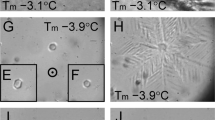Abstract
ACCORDING to the denaturation theory of injury1,2 the response of a cell to the effect of various agents is determined by conformational changes induced in macromolecules of protoplasmic proteins. In seeking to define conditions which would increase the resistance of various proteins to denaturing influences and to determine their effect on the stability of living cells, our attention was directed to the influence of D2O on proteins. Deuterization increases the resistance to heating in certain proteins, such as ribonuclease3, gelatin4, collagen5 and keratin6. We investigated the effect of D2O on resistance to heating and high hydrostatic pressure in plant (leaf epidermis of Campanula persicifolia L.) and animal (ciliated epithelium of the palate in the frog Rana temporaria) cells on one hand, and in protein preparations (muscle actomyosin of frogs and glycerin models of frog ciliated cells7) prepared according to Hoffmann-Berling8, on the other. The following resistance indices of cells and proteins were studied in the media containing D2O (test) or H2O (control): (a) the temperature at which 5-min heating irreversibly stopped protoplasmic streaming in plant cells; (b) the hydrostatic pressure which, after 5 min, stopped protoplasmic streaming in the same cells; (c) the minimal pressure which, after 5 min, stopped protoplasmic streaming in the plant cells; (d) the temperature at which ciliary movement of the frog cells ceased after 5 min or 1 sec heating; (e) the hydrostatic pressure which stopped ciliary movement after 5 min; (f) the degree of suppression of actomyosin ATPase activity after 15-min heating at 40° C; (g) the degree of suppression of actomyosin ATPase activity after 15 min at 1,300 atm.; (h) the temperature at which, after 5 min, the movement of glycerin models of ciliated epithelium in the presence of ATP is prevented. We also investigated the influence of the duration of the contact between D2O and cells, cellular models and actomyosin, on their resistance to heating and high hydrostatic pressure. The results were as follows:.
This is a preview of subscription content, access via your institution
Access options
Subscribe to this journal
Receive 51 print issues and online access
$199.00 per year
only $3.90 per issue
Buy this article
- Purchase on Springer Link
- Instant access to full article PDF
Prices may be subject to local taxes which are calculated during checkout
Similar content being viewed by others
References
Nasonov, D. N., and Alexandrov, V. Ya., Reaction of Living Matter Towards External Stimuli (Moscow, Leningrad, 1940) (in Russian).
Alexandrov, V. Ya., in Zweites Internationales Symposium über den Mechanismus der Erregung (Berlin, 1958).
Hermans, J., and Scheraga, H. A., Biochim. Biophys. Acta, 36, 534 (1959).
Harrington, van Hippel, Arch. Biochim. Biophys., 92, 100 (1961).
Rigby, B. J., Biochim. Biophys. Acta, 62, 183 (1962).
Feughelman, M., Haly, A. R., and Mitchell, T. W., Textile Res. J., 29, 564 (1959).
Alexandrov, V. Ya., and Arronet, N. J., Dokl. Akad. Nauk. S.S.S.R., 110, 457 (1956).
Hoffmann-Berling, H., Biochim. Biophys. Acta, 14, 182 (1954).
Detsherevsky, V. I., and Kornienko, I. A., Biophysica, 9, 315 (1964) (in Russian).
Pollard, E., Nature, 192, 177 (1961).
Carp, R. V., Kritchevsky, D., and Koprowski, H., Virology, 12, 125 (1960).
Monod, J., Changeux, J. P., and Yacob, F., J. Mol. Biol., 6, 306 (1963).
Koschland, D. E. Yr., Federation Proc., 23, 3, Part 1, 719 (1964).
Alexandrov, V. Ya., Quart. Rev. Biol., 39, 35 (1964).
Author information
Authors and Affiliations
Rights and permissions
About this article
Cite this article
ALEXANDROV, V., KOMAROV, V., ARRONET, N. et al. Influence of D2O on Resistance of Plant and Animal Cells, Cellular Models and Actomyosin to some Denaturing Agents. Nature 205, 286–287 (1965). https://doi.org/10.1038/205286a0
Issue Date:
DOI: https://doi.org/10.1038/205286a0
This article is cited by
-
Deuterium isotope effects on lymphoid tissues and humoral antibody responses in mice
Virchows Archiv A Pathological Anatomy and Histology (1979)
-
The responsive increase in thermostability of plant cells
Protoplasma (1970)
-
Cellular resistance adaptation to temperature and thermostability of somatic cells with special reference to marine animals
Marine Biology (1968)
Comments
By submitting a comment you agree to abide by our Terms and Community Guidelines. If you find something abusive or that does not comply with our terms or guidelines please flag it as inappropriate.



